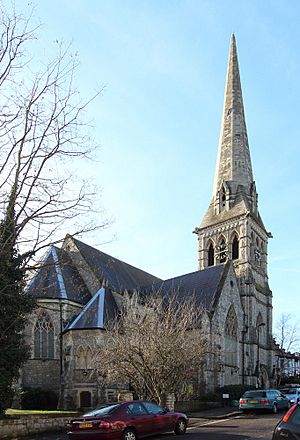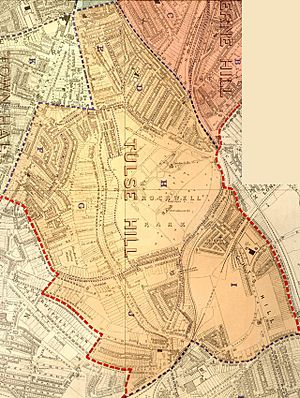Tulse Hill facts for kids
Quick facts for kids Tulse Hill |
|
|---|---|
 Holy Trinity Church, Tulse Hill (built 1855–6) |
|
| OS grid reference | TQ315735 |
| London borough | |
| Ceremonial county | Greater London |
| Region | |
| Country | England |
| Sovereign state | United Kingdom |
| Post town | LONDON |
| Postcode district | SW2 |
| Postcode district | SE21, SE24, SE27 |
| Dialling code | 020 |
| Police | Metropolitan |
| Fire | London |
| Ambulance | London |
| EU Parliament | London |
| UK Parliament |
|
| London Assembly |
|
Tulse Hill is a lively area in South London, found within the London Borough of Lambeth. It's located about five miles from Charing Cross, which is a central point in London. Tulse Hill is right next to Brockwell Park, a large green space. It shares its borders with other well-known London areas like Brixton, Dulwich, Herne Hill, Streatham, and West Norwood.
Contents
History of Tulse Hill
The land that is now Tulse Hill was once part of older estates called Bodley, Upgroves, and Scarlettes. We don't know their exact boundaries today. The name "Tulse Hill" comes from the Tulse family. They owned farmland here in the 1650s, during a time in England called the Commonwealth.
Early Owners and Land Changes
Sir Henry Tulse was a very important person; he was the Lord Mayor of London in 1683. His daughter, Elizabeth, married Richard Onslow, 1st Baron Onslow. The land stayed with the Onslow family until 1789. Then, most of it was bought by a man named William Cole. After Cole passed away in 1807, his land was split up even more.
The western part of the land went to Mercy Cressingham. Today, the Cressingham Gardens estate in the area is named after her. The eastern part, which is mostly Brockwell Park now, went to Richard Ogbourne. He quickly sold it to John Blades.
How Tulse Hill Grew
In 1810, Tulse Hill Farm was the only building in the western part of the area. In 1811, new laws called the Enclosure Acts changed how land was used in the Lambeth area. This led to the building of Effra Road nearby. Also, improvements to Brixton Road by a local group called a turnpike trust made it much easier to travel to central London. This made the land in Tulse Hill much more valuable.
Mercy Cressingham later married Dr. Thomas Edwards. In 1814, he bought more land to create a new access road from Brixton Hill. By 1821, he had laid out two new roads: Lower Tulse Hill Road (now just Tulse Hill) and Upper Tulse Hill Road. An old map from 1821 shows plans for many large houses to be built on these estates. The new roads were officially taken over by the local parish in 1822.
An 1832 map shows that Tulse Hill still had only a few buildings. This was different from nearby areas like Brixton and Norwood, which were growing faster. However, by 1843, there was a continuous line of houses along Lower Tulse Hill Road. These were mostly large, detached houses, often with separate coach houses.
Building in the area to the east started in 1845 when Trinity Rise was built. This road connected Upper Tulse Hill with Norwood Road. Holy Trinity Church on Trinity Rise was built in 1855-56. It is now a grade II listed building, meaning it's protected for its historical importance.
More major building happened after the Herne Hill and Tulse Hill railway stations opened in the 1860s. This made it even easier for people to live in Tulse Hill and travel to other parts of London.
Modern Changes
Many of the original large houses with big gardens from the 1800s have been replaced. Since the 1930s, many council housing estates have been built, meaning more homes are packed into the same space.
One important building from the 19th century that still stands is Berry House. It was later called Silwood Hall and is now the front part of St Martin-In-The-Fields High School for Girls. This school has been there for a long time, even outlasting other schools built in the 1950s.
After World War II, the London County Council rebuilt parts of Tulse Hill. They built two large secondary schools: Tulse Hill School and Dick Sheppard School. Both of these schools have now closed. Their sites have been redeveloped into new housing. For example, the Dick Sheppard School site became Brockwell Gate, which has houses and apartments overlooking Brockwell Park. The Tulse Hill school site was redeveloped into affordable housing.
Getting Around Tulse Hill
Tulse Hill has good transport links, making it easy to travel to and from the area.
Buses
Many London Bus routes serve Tulse Hill. These include routes 2, 68, 196, 201, 322, 415, 432, 468, and P13. Buses are a great way to get around locally and to other parts of London.
Trains
Tulse Hill railway station is in Travelcard Zone 3. You can catch trains here that go to London Bridge via Peckham Rye. There are also Thameslink trains that go on a loop through Wimbledon and up to St Albans. These trains stop at central London stations like Blackfriars, City Thameslink, Farringdon, and St Pancras.
The railway bridge over the A205 road at Tulse Hill used to be hit by tall vehicles quite often. A new warning system was put in place in 2017 to help prevent this.
Other nearby train stations also offer services. From Herne Hill and West Dulwich, you can get trains to Victoria. From West Norwood, you can also get trains to Victoria.
The closest London Underground (Tube) station is Brixton, which is on the Victoria line.
Roads
At the southern end of Tulse Hill, there's a big road junction. Here, the A204 (called 'Tulse Hill'), the A205 (known as the 'South Circular'), and the A215 (called 'Norwood Road') all meet. The historic Tulse Hill Hotel stands at this important crossroads.
Important Buildings in Tulse Hill
Tulse Hill is home to several interesting and historic buildings:
- Brockwell Hall - This building was constructed between 1811 and 1813. It is a grade II listed building.
- Brockwell Lido - This outdoor swimming pool opened in 1938 and is also a grade II listed building.
- Carisbrooke - A house built in the mid-19th century, which is grade II listed.
- Holy Trinity Church, Trinity Rise - Built in 1855-56, this church is a grade II listed building.
- St Martin-In-The-Fields High School for Girls - This school building was built in the mid-19th century and is grade II listed.
- Strand School - This was a Grammar School building that opened in 1913. It is now known as Elm Court School.
- 166 Tulse Hill - An old house from the early to mid-19th century, which is also grade II listed.
Famous People from Tulse Hill
Many interesting people have lived in or had connections to Tulse Hill:
- Julian Cope was the lead singer of the band Teardrop Explodes. He lived in Tulse Hill in the late 1980s.
- Michael Finnissy is a well-known composer.
- Sir William Henry Harris sang in the choir at Holy Trinity Church when he was younger, in the late 1800s.
- The astronomers Sir William Huggins and his wife Margaret Lindsay, Lady Huggins, had a home and observatory in Tulse Hill from about 1850 to 1915.
- The Ionides family lived here between 1838 and 1864. Alexander Constantine Ionides was a Greek consul and a supporter of art. His son, Constantine Alexander Ionides, gave his collection of famous old paintings to the Victoria and Albert Museum.
- Mick Jones, the guitarist from the famous band The Clash, lived in Christchurch House with his aunt when he was a child.
- Arthur Mee (1875–1943) was a British writer and journalist. He wrote popular books like The King's England and The Children's Encyclopædia.
- John Sentamu, who used to be the Archbishop of York, was the vicar (a type of church leader) at Holy Trinity Church for 13 years.
- Euan Uglow was a talented artist.




